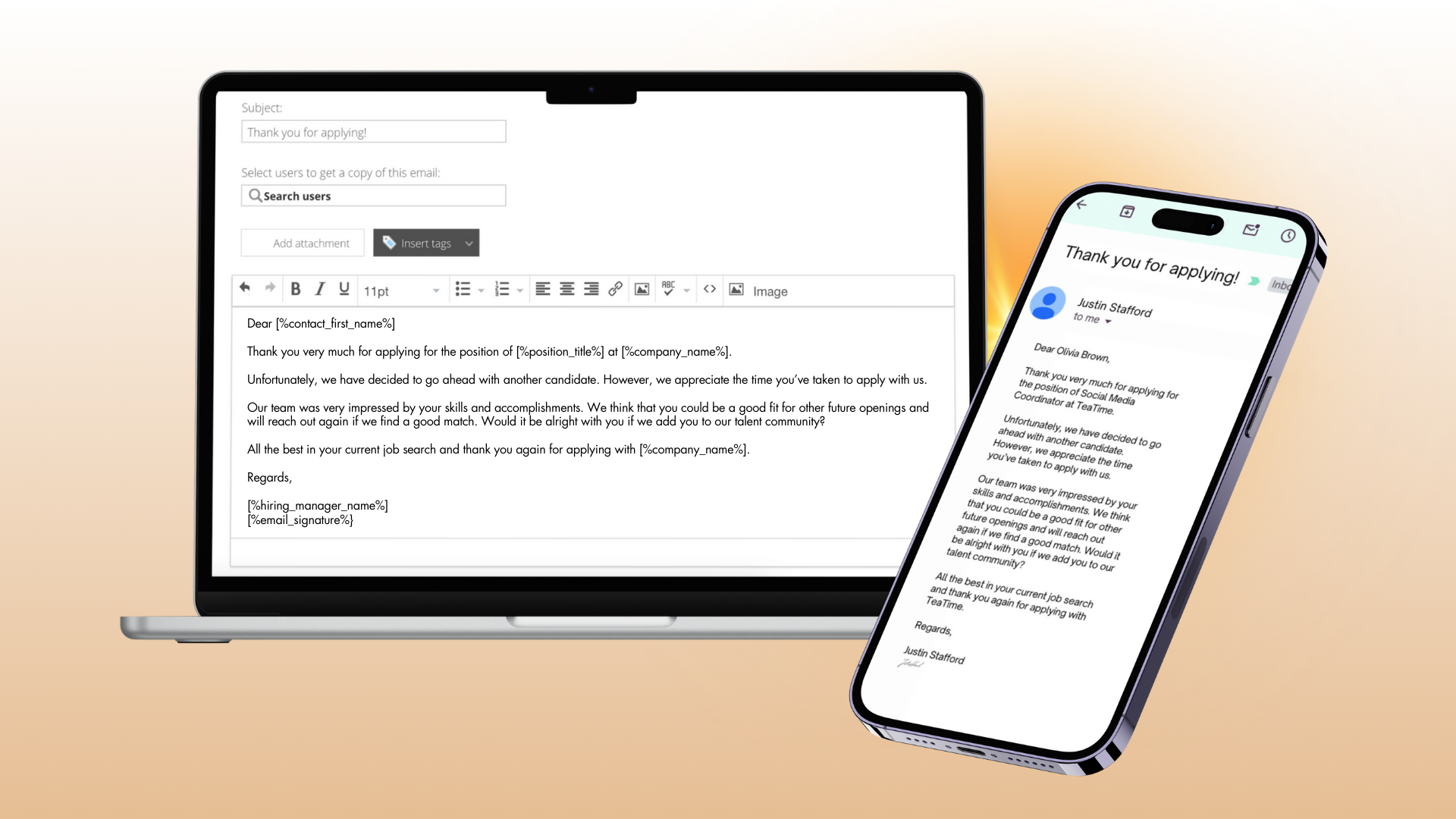Today’s rejected candidates may very well be tomorrow’s clients. And turning them down in a way that doesn’t make them feel rejected may help preserve their positive perception of your company or even encourage them to re-shoot their shot as an applicant in the future!
It’s just like dating – if a rejection goes smoothly, you may end up with a good friend or connection!
So, for the sake of your brand reputation, employer image, and overall organizational success, rejecting candidates should be handled with care. Keep the door open for potential future connections rather than burning any bridges!
To help you navigate this process, here are 5 ways to reject candidates without them feeling rejected.
1 – Personalize Rejection Emails
Personalizing rejection messages (as opposed to using a generic mass email approach) can truly make a difference. You don’t want them to think it’s just a matter of simply ruling applicants out. By adding that human touch to messages, you’re saying “We want you to know that we took the time to seriously consider your candidacy and appreciate the effort you put into applying with us”.
If you’re using an HRIS or an Applicant Tracking System (ATS), you can take advantage of the custom tags to personalize each message without having to take out more time from your day to write the email from scratch. It’ll automatically infuse messages with candidate names, and if you want, you can alter them to mention specific details from their application that stood out. This personalization will let them know that their time and effort were genuinely appreciated, not only softening the blow of rejection but also leaving the door open for future possibilities.

2 – Don’t Delay, Inform Them Right Away
Swift communication is the bedrock of a respectful and considerate recruitment process. Providing timely updates and promptly informing them of your decision to halt their application process gives them the space to explore other opportunities. This approach not only allows candidates to plan their next moves effectively and demonstrates your genuine respect for their time, but also underscores your organization’s commitment to a transparent and efficient hiring process. So, keep them in the loop and understand that a one-week delay on your end could translate to as many as ten missed opportunities for them.
3 – Ask To Add Them To Your Talent Pool
It’s important to recognize that exceptional talent is an ongoing endeavor, and sometimes, the issue lies in the timing of applications rather than the capabilities of a candidate. So, if someone showcases overall potential but isn’t an immediate fit for your current needs, extending an invitation to join your talent pool (otherwise known as talent community) becomes a valuable proposition – not just for your HR team, but to leave a positive impression on candidates.
It’s like saying, “Hey, we see your potential, and we believe in it.” By fostering a connection through talent pools, you express your commitment to nurturing relationships and acknowledge that the right opportunity might be just around the corner. It’s a win-win situation ensuring that promising candidates remain on your radar and open to future opportunities with you, while optimizing efficiency for the next recruitment cycle.

4 – Show Gratitude
Expressing gratitude is a timeless gesture, and in the realm of recruitment, it holds particular significance. Taking a moment to sincerely thank candidates for the time and effort they’ve dedicated to your application and recruitment process is more than just good practice – it can help soften any potential sting that comes with rejection.
By showing gratitude, you not only ensure that you part ways on positive terms, but this small yet impactful gesture also leaves the door open for potential connections down the road.
5 – Ask For Feedback
In your organization’s journey of continuous improvement, candidate insights matter. Asking for feedback isn’t just a formality; it’s a testament to your commitment to a two-way dialogue. It says “We genuinely value your perspective and want to ensure that the recruitment experience is not just about us assessing you, but also about understanding how we can enhance our process based on your experience.”
By opening this avenue for communication, you can leave a lasting impression that makes candidates feel heard and reflects well on your organization. You may choose to do this manually, or if you have an HRIS in place, you can leverage the custom forms feature to make it easy and convenient for candidates to share their insights with you.
Key Takeaways
As we wrap up this blog on navigating the tricky path of rejection, let’s remember that turning down candidates should be more like a friendly goodbye rather than a ghosting act. Think of today’s applicants as potential clients, or even future colleagues.
And similar to how a thoughtful rejection in dating can lead to unexpected connections, handling candidate rejections with care promotes a positive brand image and contributes to organizational success.
So, embrace these 5 approaches as the building blocks for meaningful connections and a brighter future ahead!
Contributors: Kyra Jay & Anwar Khalil

